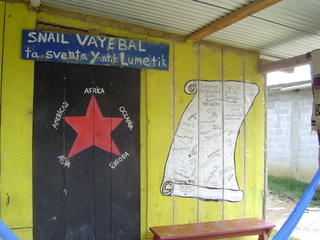
Estudiar Tsotsil
At the Oventik Language School, a 45 minute drive from the tourist destination of San Cristobal, activists can always go to study in the mist of the mountains of Southern Mexico. I say activists, because before anyone can study in Oventik, they must have a social justice or international solidarity organization send a recommendation to one of the school’s partner organizations stating that the potential student is a friend in struggle. This may seem strange, but Oventik falls in EZLN territory, the Zapatista Army for National Liberation. The group was involved in a 2 week armed struggle starting Jan.1 1994, the day the North American Free Trade Agreement came into effect (more info about them can be found in my previous writing on the subject mentioned in yesterday´s poost). Despite the tourist interest in the Zapatistas (or perhaps because of it), the Zapatistas want to assure that all students, human rights observers, and other long term visitors to their territory consider themselves part of a global struggle for social justice. In other words, rather than just a “fellow traveler,” they want all students to be "compañer@s de lucha."
The language school, on the first floor of the Autonomous Rebel Zapatista Secondary School, mainly teaches Spanish, especially to North Americans. However, those that already speak Spanish can choose to study the local Mayan language Tsotsil.
Some Interesting aspects of the Mayan language Tsotsil
Tsotsil (or Tzotzil as it is sometimes written) is one of at least 30 distinct documented Mayan languages in Southern Mexico and Central America. These languages are said to have descended from a common root “proto-Maya” which existed some 4000 years ago. Zapatitsa communities in the state of Chiapas speak some 7 or so of these languages including Tsotsil, Tseltal, Chol, and Tojolabal. While Tseltal and Tsotsil said to be mutually intelligible, it does not so seem to be so easy with the other languages.
As these languages have never been official languages since the Spanish conquest, even within the Zapatistas, community representatives have to learn Spanish to be able to communicate with Zapatistas from different linguistic zones. Furthermore, the isolation imposed on many communities has caused each language to have numerous regional variants with different pronunciation, different conjugation and some different vocabulary.
Study of the Mayan languages seems to be increasingly popular, perhaps because of the Mexican and international interest in the indigenous communities that have risen up in the “War against oblivion” (“Guerra contra el olvido”) to demand rights and respect. Of the three books I found to help me learn, one Spanish-Tsotsil-Tseltal-Chol-Tojolabal dictionary and two Tsotsil workbooks all were printed in this millennium (2001, 2004, 2005). Unfortunately, they contain two different variants of Tsotsil, both of which are different from what is taught at Oventik.Other interesting aspects about the Use of Tsotsil.
Tsotsil, like other indigenous languages of the Americas, has incorporated a lot of Spanish influences in its day to day use. Nevertheless, many concepts, sounds, and forms of expression that pre-date the European presence here make Tsotsil a very interesting language to learn.
For example, the Tsotsil alphabet contains glottal morphemes not found in any Western language. In other words the sounds ch’, k’, p’, t’, ts’ and a’,e’,I’,o’,u’, are different from ch,k,p,t,ts,a,e,I,o, and u. To pronounce the vowels with apostrophes, one closes the vocal chords after making the vowel sound. This is akin to the effect produced when some drop the ‘th’ in “nothing” to say “nu’in” (like the “nu’in” Honey Crunch commercials).
The glottal consonants are even more interesting. They are called “explosive” because one produces these sounds by momentarily blocking air movement, building up pressure with the lips and/or the tongue. When this pressure is released, it sends out a blast of air that causes a strong consonant sound and a momentary pause before the enunciation of the following sound.
Since language is also an expression of culture, Tsotsil offers an interesting glimpse into Mayan concepts. For example, Tsotsil, like English but unlike Spanish, does not differentiate between formal and informal usage of “you” in its pronouns or conjugation. However, there are two distinct concepts of “we.” “Jo’otik” means “we” including the listener/audience, “Jo’onkutik” excludes the audience. Notice, these words are from the vocabulary of the area around Oventik. In Zinancantan they say “Vo’otik” and “Vo’onkotik.”
The two most interesting concepts reflected in the Tsotsil have to do with 1) the concept of time and 2) the relationship between the subject and object of an action. Both of these are very different from the European concepts, so be sure to tune in to tomorrow´s addition.
No comments :
Post a Comment